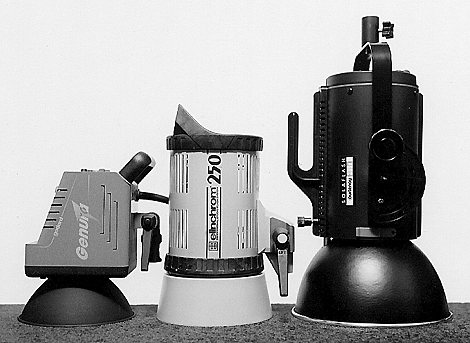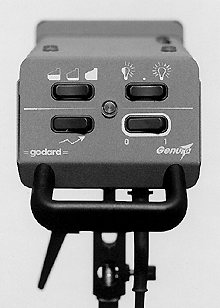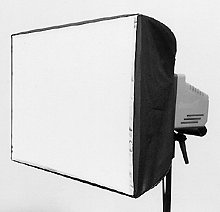
Godard's tiny Genura flash

Having tested six manufacturers' monoblocs in this survey to date, the thought
of a seventh might be enough to drive any reviewer to despair. Fortunately,
the series shifts gear at this stage, turning to some of the less obvious
and lower priced contenders. First off is the Godard Genura, which sits
mid-way between the two camps. In short, this is a 300J monobloc that looks
totally unlike everything that has gone before. Forget the basic tubular
shape favoured by Systems Imaging, Broncolor, Elinchrom/Prolinca, Bowens,
Courtenay and Multiblitz: instead, the Godard Genura is housed inside a
truncated cube.
The aesthetics are a little unfamiliar but rather pleasing nevertheless.
In addition, they score very well in terms of compact design. Measurements
alone don't convey how compact these units are. Instead, look at the comparison
picture shown here, which pitches the Genura against some of the other units
tested to date. If size is of prime importance, the Genura clearly has a
distinct lead from the start. Godard's small wonder is also correspondingly
lightweight, tipping the scales at about 1.8kg for the monobloc alone. Unfortunately,
direct comparisons with other manufacturers' offerings are hampered by the
fact that the Genura's cable is permanently attached - unlike that of other
monoblocs (except Courtenay's). The weights quoted in manufacturers' data
sheets, and also confirmed on test, do not include detached cables. In the
interests of fairness, the Genura's quoted weight therefore excludes the
cable. But size and weight aren't everything, there is also the question
of power.
The three monoblocs shown in the comparison picture are all 250-300J models
p; the Elinchrom 250, the other two 300 (though an Elinchrom
500 is identical in size to the 250). Of course, some readers' suspicions
may already be aroused regarding the price of the Genura. Is this a case
(as in "mini" hi-fi systems) that cost is inversely proportional
to size p; a matter of paying for what you don't get rather than for
what you do? Actually, no. The Genura isn't quite the cheapest monobloc
around, but it is far from expensive: the basic unit is just £284 (excluding
VAT). A protective cap is provided as standard, as is a sync cord, but a
reflector isn't. Either of the most likely choices (a conventional 18cm
dish or a slightly smaller version with an umbrella slot) will set you back
a further £27. It is worth noting that manufacturers vary in their
approaches, some favouring inclusion of a reflector in the price while others
throw-in a protective cap. Nobody, to my knowledge, gives both.
Unfortunately, this variation hinders direct price comparisons. The Bowens
Esprit 250, following March's price rise, is now £315 without a
reflector whereas the Courtenay 300x
is £297 with one. The Genura totals £311 with both reflector and
protective cap. To summarise so far, Godard's Genura is unconventional in
appearance, small in size, moderate in power and on the low side of the
available price range. So where's the problem? Why isn't everybody using
Genuras?
There are three possible answers. Firstly, you may never before have heard
of Godard, let alone the Genura. The system is imported by Microfield Scientific,
a small specialist company you can deal with directly. Photon readers will
have seen advertisements for this and other Godard flash units in recent
months. Secondly (but not uniquely), the accessories offered are rather
limited. Lastly, Genura monoblocs are relatively inflexible. Part of this
inflexibility is due to the 300J output (there is only one Genura model)
and part is due to the way that the power can be used. The monobloc's rear
panel has just four controls p; and two of those are the main on/off
button and the flash test button. Otherwise, there's a modelling lamp switch,
with full, half-power and off positions, and a flash output control that
offers full, half-power and quarter-power settings.


The rear panel is completed with a green power-on/flash ready indicator
(which extinguishes during recycling). On the underside there is a 1/4in
sync cable socket, the fuse holder and the mains cable, which, as has already
been noted, is permanently attached. On the top plate are two flash sensors.
Plugging a sync cable into the socket does not deactivate the sensors, making
individual output readings difficult when using multiple head lighting set-ups.
The front-mounted accessory release button can prove difficult to reach
when a large softbox is fitted. The flash output is sufficient for most
likely uses of the kit, giving 8 at 1.5m when the softbox is fitted (see
above). Unfortunately, the Genura is yet another monobloc that lacks flash
inhibition to prevent firing at less than full recharge. The pros and cons
of this feature were covered in some detail last
month.
Flash duration to t(0.5) is quoted at 1/2,000s with recycling times of 1s
or less. Both figures are on the fast side. It is worth noting that flash
duration is generally related to maximum power output and the diameter of
the flash tube: the Genura's small tube helps to explain the brief duration.
As an aside, it is worth asking whether we are being misdirected by flash
durations. I do not propose to answer this question myself, but leave the
issue open for debate. If 1/60s at 8 is fine outdoors, why do we need 1/1,000
or faster in the more controlled studio environment? The Genura outfit under
review here comprises two monoblocs, a brolly with matching reflector, a
small softbox and a sync cable.
Everything is packed inside a 7 x 16 x 22in black plastic suitcase that
is similar in design to the case recently introduced for Prolinca or Elinchrom
kits. At £750 (excluding VAT), the outfit is £100 cheaper than
the same power Courtenay kit, though the latter also includes stands, another
reflector, another brolly and a flashmeter. Given the compact size of the
Genura monoblocs, the case is bigger than need be p; bigger even than
the aforementioned Elinchrom case. Also, the review kit's case seemed to
open the wrong way up: normally when a case is unlocked the clips are lifted
up towards the lid, whereas this case's clips pull down towards the base.
The softbox supplied is a Chimera Mini. As with most collapsible types,
the front panel looks creased when unpacked but smooth when brightly lit
from behind. A nice feature is wrap-around from the side panels onto the
edge of the front surface, giving a black defining line around the light
panel area. I must confess to not having used a Chimera softbox before (having
preferred Wafers), but this small, deep design definitely qualifies for
my wants list.
Surprisingly, given their limited flexibility, the Genura monoblocs also
qualify, though on a purely objective level, they probably shouldn't. It's
a shame that the 100W modelling lamp isn't brighter, and it's an irritation
not to be able to switch off the slave sensors, but still the lasting impression
is favourable. In this sense, the Genuras are proof of why reviews such
as this can only be of limited value in terms of guiding potential purchasers.
There is something of the Broncolor syndrome here: the Swiss Minipuls lights
may have their failings, but they are still very desirable. The same is
also true of the French Godards. So if you're looking for compact, lightweight
300J monoblocs, look closely at the Godard Genura. But look with you heart
as well as with your head, for there is an undefinable quality about these
lights that makes them very much more attractive than their specifications
might at first suggest.
Return to Photon May 96 contents





